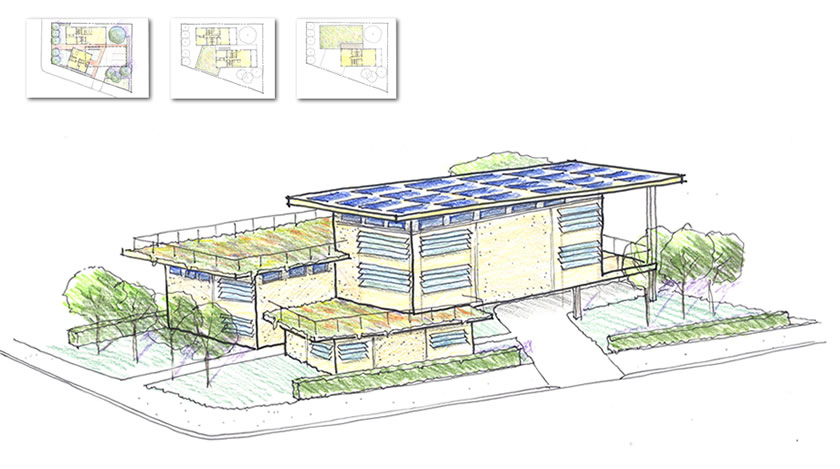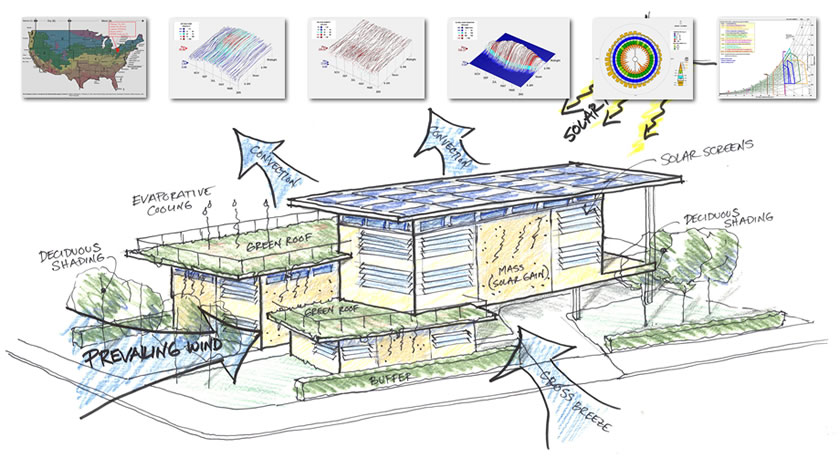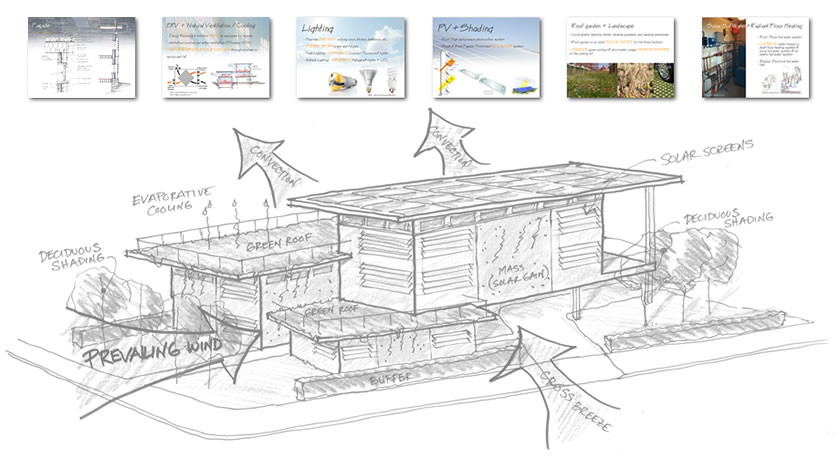Zero Energy Performance
- Energy consumption:
- Site Energy Usage Intensity (EUI): 8 MBtu/ft2 yr (or 25.2 kWh/m2 yr)
- Estimated total energy consumption in one year: 36,800 MBtu (or 10,792 kWh)
- Energy Recovery Ventilator (ERV): more than 90% cooling/heating energy is reused in winter and summer
- Natural cooling and ventilation in fall and spring: zero energy consumption
- U-factor of 0.1 – 0.2 Btu/hr-ft2-F low-E glass to reduce solar heat gain in summer and reduce internal heat loss in winter
- Motorized shades to prevent high angle solar heat gain in summer and allow low angle solar heat gain in winter
- Green roof to provide increased cooling capacity due to evapotranspiration and reduce heat flux at roof membrane
- R-50 wall assembly
- Integrated solar hot water, domestic hot water (DHW) and radiant floor heating system to reduce DHW and heating energy usage
- Maximized vegetation to reduce Urban Heat Island effect
- Energy generation:
- Estimated total roof area: 3,000 square feet (or 278.71 m2)
- According to DOE A Consumer Guide to Solar Electricity for the Home, we assume a 1kW PV system needs 175 square feet unshaded roof area, in addition to PV shades in south and west façade, we design a 12 kW PV system for the three families
- According to NREL - Renewable Resource Data Center, we assume 12kW of DC rating, 0.77 of DC to AC derate factor and fixed tilt installation, in Pittsburgh Pennsylvania, the estimated total energy generated by photovoltaic in one year is 13,185 kWh (or 44,961 MBtu)
- Net site energy balance in one year: 2,393 kWh (or 8,161 MBtu)
- Combine rooftop PV area and façade shade PV area to maximize electricity generation production
Spatial Performance
- Total gross floor area: 5500 square feet (or 511 m2)
- Total conditioned floor area: 4600 square feet (or 427 m2)
- 2 people family: 1 Living room + 2 Bedrooms + 1 kitchen + 1 bathroom
- 4 people family: 1 Living room + 3 Bedrooms + 1 kitchen + 3 1/2 bathrooms
- 6 people family: 1 Living room + 5 Bedrooms + 1 kitchen + 3 1/2 bathrooms
- Livable spaces are at the perimeter with vegetation barriers to provide privacy
- Outdoor parking and walking path
- Accessible roof garden for socialization within the three families
Thermal Performance
- Passive strategies to ensure more than 50% thermal comfort, including shading, high thermal mass, natural ventilation, passive solar heat gain, internal heat gain
- Radiant floor heating and energy recovery ventilator (ERV) are used to meet the heating and cooling load and provide enough fresh air when natural ventilation cannot be used in winter or summer
- ERV utilized to mitigate moisture content in conditioned air, which is important in Pittsburgh (relative humidity is above 80% for 38% of one year)
Visual Performance
- Higher than 25% window/wall ratio to ensure enough daylight and nature view in livable spaces
- Using 2700K – 5000K color temperature lamps and 300 – 500 lux illuminance level in different spaces of the apartment to ensure comfortable and functional light level at night
- Indirect light fixture to prevent electrical lighting glare
- External shades to prevent sunlight glare
Acoustic Performance
- Green roof and other vegetation to absorb noise
- Wood framing structure to reduce noise
- Detached parking space to reduce car noise
Indoor Air Quality
- Natural ventilation and ERV to provide outdoor fresh airs
- Detached parking space to reduce the amount of car exhausted pollutants to go into the house
The “City of Bridges,” long known for it’s industrial heritage, is recognized more recently as being an environmentally conscious city. Many new commercial and residential buildings in Pittsburgh are incorporating energy saving strategies and low-carbon-impact materials in their make-up. Unfortunately, the city is still characterized by turn of the 20th century inefficient brick or stone homes, either, row, duplex or single-detached. In addition, the building stock and neighborhoods are as varied as the city’s terrain. Although generally more urban than suburban the density of the city is a factor of the topography and lingering connections to long-gone steel mills.
Ironically, former sites of once large steel and coke factories are now enclaves of newer low-rise low-density town houses. The historic Southside neighborhood has seen a number of these new developments and it is within this setting we assume the Dow Competition Zero-Energy Housing project to be located. Although the competition site is larger than a typical lot size in this area, it is not uncommon for properties to be combined for development of multiple buildings on a single site. The proposed setting is urban in character, but we shall take advantage of the generally lush environment of Western Pennsylvania and the gentle breezes along the Mon Valley by strategically adding to the given site vegetation. For the purposes of this competition we are assuming that the “Avenue” is a more travelled roadway and the “Street” has a more residential character: even though the roads of the given site plan do not conveniently align with the city grid pattern as indicated below.
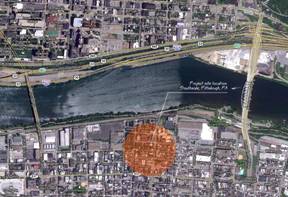
Site location - Southside - Pittsburgh
Image courtesy of GOOGLE Earth
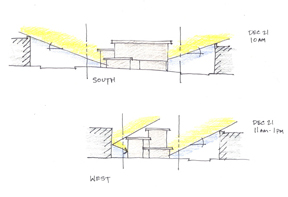
Site Context - Solar Shading
Summers are mild with occasional extremely hot periods. Relatively high humidity levels do exceed comfort levels, however, typically during the months of July and August. The spring and fall are exceedingly pleasant though short lived, Rainy months are typically during the months of April and May. Prevailing winds for the Pittsburgh area are generally from the northwest during cooler months and from the southwest during warmer months. Winters can be bitterly cold at times although the microclimate near the river does not fluctuate wildly due to tempered ambient temperatures from the river.
The images below illustrate a representative residential building in the neighborhood alongside our proposed schematic design. We have approached the design with this context in mind. There are some design decisions that at first blush seem to be competing but that we felt ultimately allow for a pleasing spatial experience. We have taken advantage of a broad face to the south with the building massing that allows for unobstructed sun and summer breezes while tempering northern winter breezes with stepped massing.
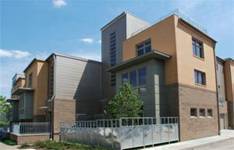
Southside Flats - Pittsburgh
Image courtesy of RE/Max

Pro-Environment Living
Three story structures are not uncommon in this neighborhood yet the generous site affords an opportunity to provide yards throughout. Despite having the six person unit placed to the north of the elevated four person unit (see floor plans), the site access and sun exposure for the Shadovoltaic panels was increased while maintaining a contextual street presence. The design also provides for a balance of shadowed and fully exposed garden spaces as well as building surfaces. We have minimized the hardscape to lessen the impact on the city's already overburdened storm water system. Vegetated "green roofs" provide additional storm water retention benefits as well as cooling load (local) and heat island effect (neighborhood) reduction. Deep overhangs along with a Shadovoltaic screening system provide shading during summer months when temperatures often remain above 80 F (26 C) during the summer with humidity levels consistently above 60%. Additionally, adjustable Shadovoltaic panels improve day-lighting comfort while generating electric power. Deep-room light levels are enhanced during winter months by clerestory windows and during milder periods assist, in conjunction with an ERV system, to provide ventilation.
A radiant floor system provides comfortable clean indoor warmth during the heating season when temperatures may not climb above 30 F (-1 C) for weeks at a time. A solar water collector system in conjunction with an integrated high efficiency boiler and water tank can provide required domestic hot water and radiant liquid for the three residences all while reducing CO2 emissions. The radiant tubing effectiveness shall benefit from the mass provided by encasing them in concrete (1.5 inches over reflective foil). The building envelope shall insulate with NuWool, a recycled cellulose, that can provide increased R-value for similar depth of material, in the wall cavity while decreasing heat loss through air infiltration. Additionally, rigid insulation is applied outside of the air barrier with a 2” air gap to equalize pressure differentials reducing moisture migration for a total wall R-value of 50 or U-value of .02 (Btu/sq.ft. h F) in the wall cavity.
A 3000 square foot Roof provides ample room for solar water collectors in addition to a photovoltaic (PV) electricity generation system. The intent, however, is to reduce energy load as much as possible first and use the PV system as supplemental and reserve bank energy. For instance, day lighting shall be improved reducing the need for artificial light, storing excess produced electricity back to the grid. There are inherent and long-term concerns with relying on the grid as a battery system in the United States, but it is the most effective means to date. When artificial lighting is unavoidable, compact fluorescent and T5 H.O. lighting shall be used with LED lighting in select areas. High efficiency appliances along with gas ranges, boiler and clothes dryers shall be used in order to reduce source energy demand, as gas is still more economical than electricity in that regard.
Total energy consumption within a year is expected to be approximately 36,800 MBtu with a corresponding Energy Use Intensity (EUI) of 8 MBtu/sq ft yr. We expect to offset this consumption with electric generation of 13,185 kWh (or 44,961 MBtu). These figures are conservative on both sides of the equation, with more specific parameters expected to reduce loads, which in turn should lower power generation needs. These figures are relate to net zero energy at site. Source net zero energy should be far exceeded.
It should be pointed out, however, that the full intent of the design is not to merely overcome consumption with generation. The dwellings are certainly designed to benefit the occupants in terms of thermal comfort with reduced energy costs. But spatial definition, visual pleasure, and the comfort that comes from a safe and healthy environment are the exemplary goals for residential design. Utilizing local products with “environmentally friendly” components fabricated with care for the local and global terrain while reducing waste are all expected practices summarily assumed to be incorporated into the design.
